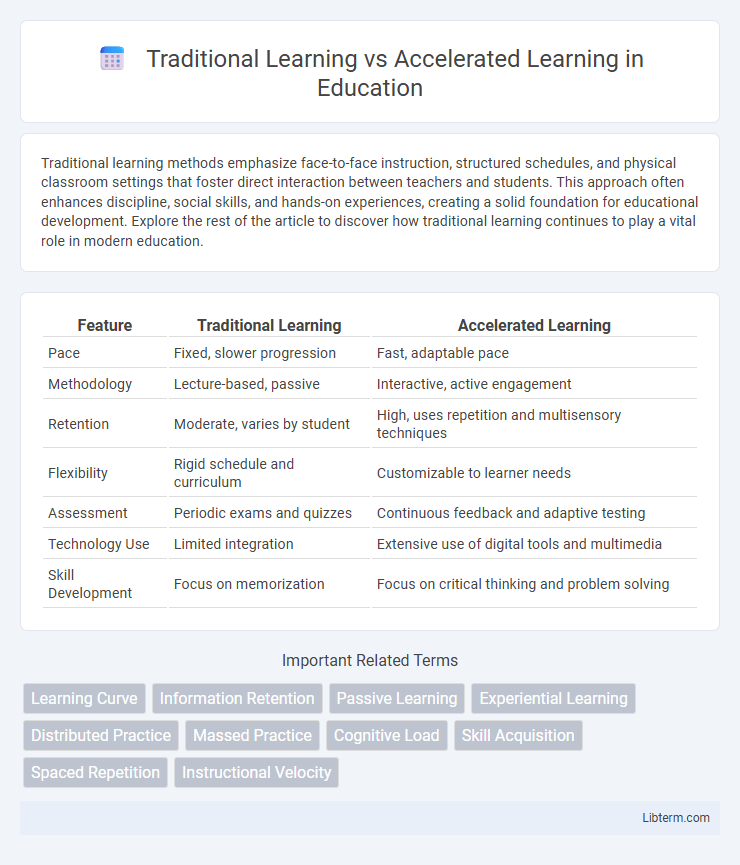Traditional learning methods emphasize face-to-face instruction, structured schedules, and physical classroom settings that foster direct interaction between teachers and students. This approach often enhances discipline, social skills, and hands-on experiences, creating a solid foundation for educational development. Explore the rest of the article to discover how traditional learning continues to play a vital role in modern education.
Table of Comparison
| Feature | Traditional Learning | Accelerated Learning |
|---|---|---|
| Pace | Fixed, slower progression | Fast, adaptable pace |
| Methodology | Lecture-based, passive | Interactive, active engagement |
| Retention | Moderate, varies by student | High, uses repetition and multisensory techniques |
| Flexibility | Rigid schedule and curriculum | Customizable to learner needs |
| Assessment | Periodic exams and quizzes | Continuous feedback and adaptive testing |
| Technology Use | Limited integration | Extensive use of digital tools and multimedia |
| Skill Development | Focus on memorization | Focus on critical thinking and problem solving |
Introduction to Traditional and Accelerated Learning
Traditional learning relies on structured classroom environments, fixed curricula, and teacher-led instruction, emphasizing memorization and repetitive practice. Accelerated learning incorporates interactive techniques, multisensory engagement, and neuro-linguistic programming, aiming to speed up knowledge acquisition and retention. Both methods serve distinct educational goals, with traditional learning focusing on foundational knowledge and accelerated learning prioritizing efficiency and adaptability.
Defining Traditional Learning Methods
Traditional learning methods emphasize structured, instructor-led classroom environments where knowledge is delivered through lectures, textbooks, and standardized assessments. This approach prioritizes memorization, repetition, and adherence to a fixed curriculum to ensure mastery of foundational concepts. The emphasis on teacher authority and passive student engagement characterizes traditional education models prevalent in schools and universities worldwide.
Key Principles of Accelerated Learning
Accelerated learning relies on key principles such as active engagement, multisensory input, and immediate application of knowledge to enhance retention and comprehension. It emphasizes neuroplasticity, leveraging brain-friendly techniques like spaced repetition, mindfulness, and chunking to optimize cognitive processing. This approach contrasts with traditional learning by prioritizing speed, efficiency, and personalized feedback to achieve faster mastery of skills and information.
Comparison of Learning Objectives
Traditional learning emphasizes comprehensive mastery of subject matter through fixed curricula and long-term retention, focusing on foundational knowledge and skill development over extended periods. Accelerated learning targets rapid acquisition and application of specific skills or knowledge, prioritizing efficiency and goal-oriented outcomes often tailored to immediate practical use. The comparison highlights traditional learning's depth versus accelerated learning's speed and adaptability in achieving educational objectives.
Classroom Environment and Structure
Traditional learning typically involves a structured classroom environment with fixed schedules, standardized curricula, and teacher-led instruction designed to accommodate a broad range of learners. In contrast, accelerated learning emphasizes flexible, learner-centered environments that incorporate active engagement, multimedia resources, and collaborative activities to enhance information retention and critical thinking skills. This adaptive classroom structure fosters personalized pacing and experiential learning, reducing time to mastery compared to conventional methods.
Time Commitment and Flexibility
Traditional learning often requires a fixed schedule with long-term time commitments, limiting flexibility for students balancing work or personal responsibilities. Accelerated learning compresses content into shorter periods, enabling learners to achieve goals faster while adapting study times to their individual needs. This flexibility and reduced time investment make accelerated learning ideal for professionals seeking efficient skill acquisition without disrupting daily routines.
Role of Technology in Both Approaches
Traditional learning relies on face-to-face instruction and physical materials, with technology often used as a supplementary tool for presentations and basic research. In accelerated learning, technology plays a central role by providing interactive multimedia, personalized learning paths, and real-time feedback through adaptive software and digital platforms. The integration of artificial intelligence and virtual reality enhances engagement and speeds up knowledge acquisition, making accelerated learning more efficient than traditional methods.
Outcomes and Retention Rates
Traditional learning methods often result in slower knowledge acquisition and lower retention rates due to passive information absorption and limited practical engagement. Accelerated learning techniques enhance outcomes by utilizing active learning strategies, multisensory inputs, and spaced repetition, which significantly improve retention and comprehension. Research indicates accelerated learning can increase retention rates by up to 60% compared to traditional learning models, fostering faster skill mastery and application.
Pros and Cons of Each Learning Style
Traditional learning offers structured curriculum and consistent pacing, promoting deep knowledge retention but may limit flexibility and learner engagement. Accelerated learning enhances information absorption through active techniques and condensed timelines, increasing efficiency but potentially sacrificing thorough understanding and long-term memory. Balancing both methods can optimize knowledge acquisition by combining comprehensive content with dynamic learning strategies.
Choosing the Right Learning Method for Your Needs
Choosing the right learning method depends on individual goals, time availability, and cognitive preferences, with traditional learning emphasizing structured, comprehensive knowledge acquisition over extended periods. Accelerated learning techniques leverage mnemonic devices, chunking, and active recall to enhance retention and speed, making them ideal for learners seeking rapid skill acquisition or exam preparation. Evaluating personal learning style, subject complexity, and flexibility requirements ensures optimal alignment between method and desired outcomes, maximizing educational effectiveness.
Traditional Learning Infographic

 libterm.com
libterm.com